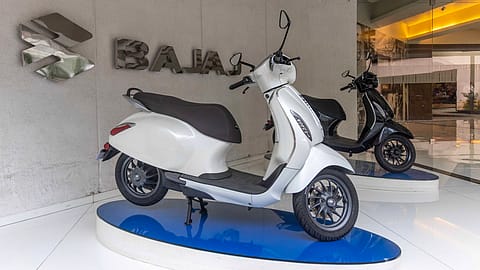Bajaj Auto sees 50% drop in electric scooter output in Q2 amid rare earth crisis
Bajaj Auto aims to de-risk rare earth supply constraints by the end of the financial year 2025-26.

Bajaj Auto Ltd expects half of its electric two-wheeler output to be hit due to the ongoing rare earth magnet crisis, even as the automaker looks at re-designing motors and alternate sources of supply, according to a top company executive.
“At this point of time, it looks like we might be able to deliver about 50-60% of our two-wheelers for this quarter and about 70-80% of the three-wheeler,” Dinesh Thapar, chief financial officer at Bajaj Auto, said in a media conference call after the Chetak scooter maker announced its first quarter earnings.
China, the world’s largest producer of rare earth magnets, has stopped shipments to India since April. India imports roughly ₹300 crore of rare earth magnets from China annually.
Bajaj Auto is counting on “tactical interventions” to deal with China’s rare earth magnet curbs. In the short term, it is redesigning motors used in EVs with Less Rare-Earth (LRE) permanent magnet grades instead of Heavy Rare-Earth grades. It is also looking at sourcing magnets from countries other than China.
Over the long term, Bajaj Auto plans to potentially de-risk this supply issue by designing components that do not involve rare earths. “We should be able to de-risk all of the by the end of the financial year,” said Thapar.
The company has formed a “crack team” to look at the immediate options.
There was a time when August was looking to be a complete washout for EVs but the team has been able to work on tactical interventions, said Thapar. “We might be able to salvage output in August. It could be about 40% of volume which might have looked near zilch,” he said.
Recommended Stories
“While August will be very strained, we are hoping that some of the actions will start to play out in September,” Thapar said. “Till such time, in the next couple of months, it will be really tactical actions that we will take to look at alternate options, whether it is LRE or additional sources,” he explained.
The rare earth magnet crisis is going to hit Bajaj Auto’s festive season plans. “With the festive season ahead in September, even if we unlock a lot of supply after this, there is likely to be an impact in terms of the festive sales we would have liked. Given the buoyancy that was building up for Chetak, we had a very big plan for the festive season. We will likely meet only 50% of that plan,” said Thapar.
The longer-term play is to make motors that are made without rare earths, the Bajaj Auto CFO said.
The Indian government has yet to make any headway on getting China to ease its curbs on rare earth exports to India. While India has the raw material for magnets, it lacks the processing technology, making the country dependent on imports from China.
(INR CR)
Bajaj Auto reported a 14% year-on-year jump in consolidated net profit to ₹2,210.44 crore for quarter ended June. Revenue from operations rose 10% to ₹13,133.35 crore in Q1 FY26.
Resurgent exports and scaling up of the electric portfolio more than made up for the domestic motorcycle performance, which although improving over previous quarter, had a subduing effect on the overall growth Electric vehicles contributed over 20% to domestic revenues compared to early teens same time last year. Bajaj Auto emerged as the leading electric three-wheeler maker (L5 category) for the first quarter, achieving leadership in under two years since its launch.
